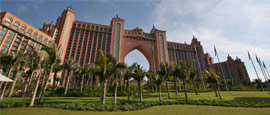At 828m-high (2,717ft), the Burj Khalifa is one of the world’s tallest building. It features the highest public observation deck on the planet, offering unparalleled city views from the 148th floor. It’s also home to the first-ever Armani Hotel. The skyscraper, which opened in 2010, still remains one of the city’s must-see attractions.
Things to see in Dubai
Tourist offices
Address: Airport Road, Al Garhoud, Dubai, D89, United Arab Emirates
Tel: +971 600 555 559.
Opening Hours:
Sun-Thu 0800-1700.
www.visitdubai.com/enWith information on everything from activities to attractions, the Welcome Bureau can help sort your entire trip, including booking accommodation, shows and restaurants. It also has offices available in most major malls, including City Centre and Ibn Battuta.
The 14km (8.7 mile) Dubai Creek is a natural seawater inlet that divides central Dubai into two parts: Deira and Bur Dubai. Despite numerable high-rises, the creek retains an old-world charm. At the inland end, a wildlife sanctuary is home to over 27,000 birds, though boutique hotels and yachting clubs line the banks too.
Housed within one of the city’s oldest buildings, the Al-Fahidi Fort, Dubai Museum opened in 1970 and remains one of Dubai’s top tourist attractions. The exhibits range from old weapons and pearl-diving outfits to an impressive range of military artefacts and pieces taken from the 4,000-year-old graves at Al-Ghusais.
One of the city’s most photographed buildings, the Jumeirah Mosque is an impressive example of modern Islamic architecture. Built along medieval Fatimid lines, it has two minarets and is subtly lit up at night. Non-Muslims are not allowed to enter mosques in Dubai, although the Jumeirah Mosque allows non-Muslims to visit via an organised tour.
One of Dubai’s biggest waterparks, Aquaventure makes up part of the Atlantis hotel complex and contains a series of pools, shoots and flumes – among them the hair-raising Tower of Neptune and the equally scary Tower of Poseidon. If that wasn’t enough, there’s also a zip-line and a dolphin pool.
Historic Bastakiya is one of the few parts of Dubai with a pedigree beyond the 1970s. Stroll past local houses and courtyards alongside Dubai Creek, and take in the traditional wind towers that were once used to cool homes. There is also a modest museum here, plus a sprinkling of cafés, small art galleries and a Saturday street market.
When B21 Gallery first broke ground, it was a pioneering enterprise in terms of displaying contemporary Middle Eastern art in Dubai. Now, Gallery Isabelle van den Eynde has taken the torch, and it is the best place to see original, and often challenging, works from regional artists and beyond.
A recreation of two early Emirati village, the emphasis is on recalling the Bedouin way of life, with barasti housing, traditionally-dressed locals, handicraft displays and pearl diving paraphernalia - once the mainstay of the Gulf. During winter months, the area comes alive with traditional song and dance.
Occupying the 12-hectare (30-acre) Burj Khalifa Lake, and shooting jets of water 150m (492ft) into the air, the Dubai Fountain is the world’s largest choreographed water feature. Its jets are synchronised to a light show every half an hour to spectacular effect. Entry is free, but the best views are from the tables at one of the many waterside bars.
Said to be visible from space, the three Palm Islands are the largest man-made islands on the planet. Palm Jumeirah boasts hotels and a marina, but construction has only recently resumed on Palm Jebel Ali and Palm Deira following the recession. Work has continued too on The World, an ambitious attempt to recreate the global map using 300 offshore islands.
Do you have any Feedback about this page?
© 2025 Columbus Travel Media Ltd. All rights reserved. No part of this site may be reproduced without our written permission, click here for information on Columbus Content Solutions.








 You know where
You know where